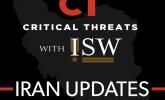Russian Offensive Campaign Assessment, July 7, 2023
July 7, 2023 - ISW Press
Ukrainian forces made tactically significant gains in the Bakhmut area and continued counteroffensive operations in at least three other sectors of the front on July 7. Geolocated footage published on July 6 indicates that Ukrainian forces have made tactically significant gains near Yahidne (2km north of Bakhmut). The Ukrainian General Staff reported that Ukrainian forces conducted offensive operations north and south of Bakhmut, and Ukrainian Ground Forces Commander Colonel General Oleksandr Syrsykyi reported that Ukrainian forces established control over unspecified previously lost positions in the Bakhmut area.Ukrainian General Staff Spokesperson Andriy Kovalev reported that Ukrainian forces also achieved partial success near Klishchiivka (7km southwest of Bakhmut).The Ukrainian General Staff reported that Ukrainian forces continued offensive operations in western Zaporizhia Oblast and along the administrative border between Zaporizhia and Donetsk oblasts.The Russian Ministry of Defense (MoD) and other Russian sources claimed that Ukrainian forces conducted offensive operations in the Kreminna direction along the Kharkiv-Luhansk Oblast border.










